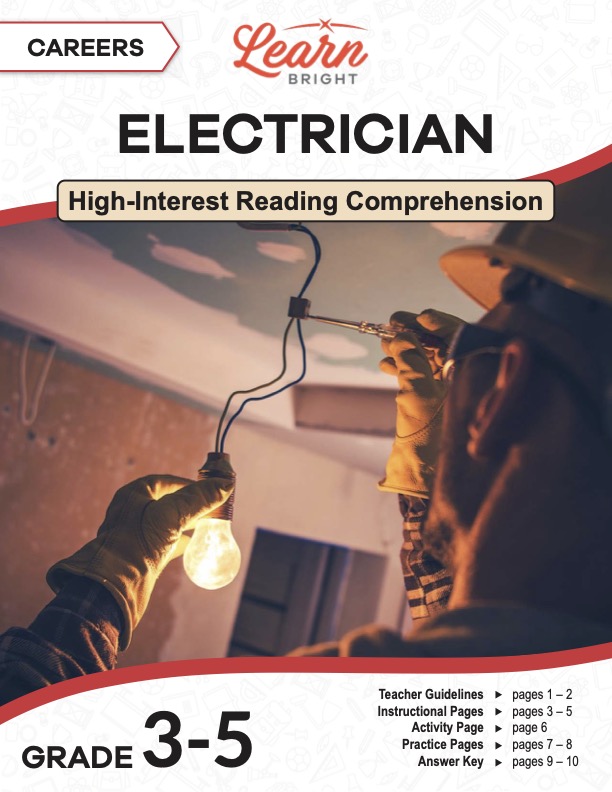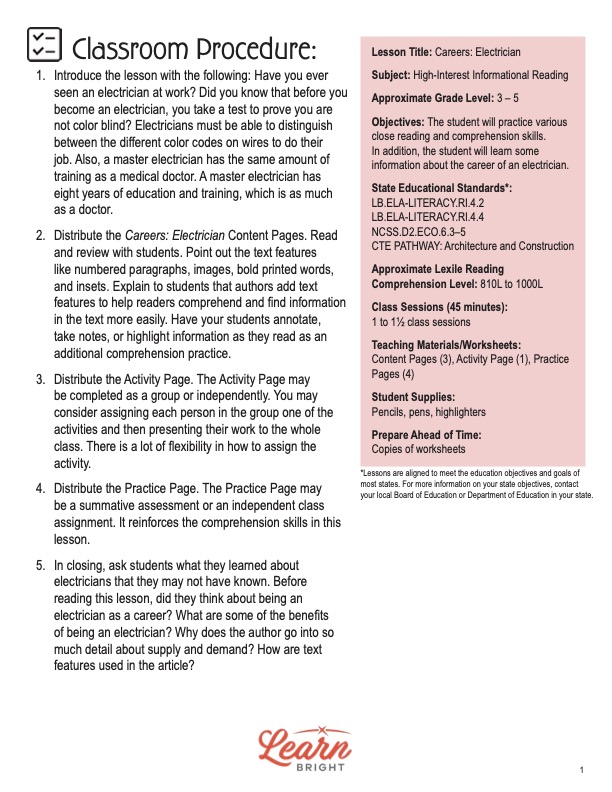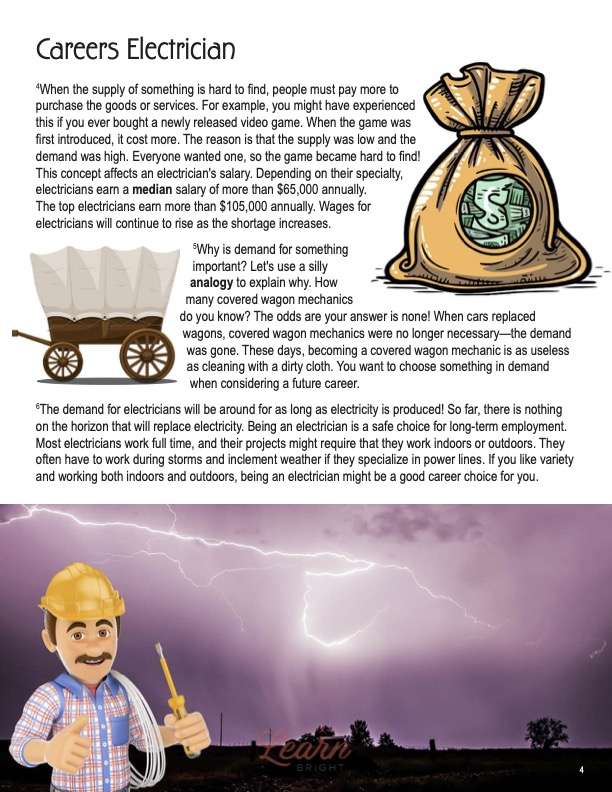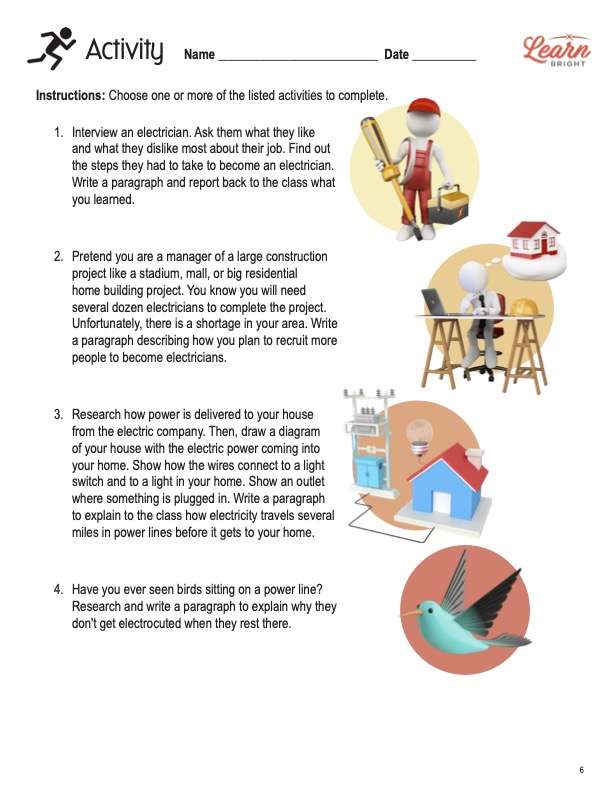Description
What our Careers: Electrician lesson plan includes
Lesson Objectives and Overview: Careers: Electrician is a high-interest reading comprehension lesson plan. As such, students will practice various close reading and comprehension skills. In addition, they will learn some information about the career of an electrician. This lesson is for students in 3rd grade, 4th grade, and 5th grade.
Classroom Procedure
Every lesson plan provides you with a classroom procedure page that outlines a step-by-step guide to follow. You do not have to follow the guide exactly. The guide helps you organize the lesson and details when to hand out worksheets. It also lists information in the yellow box that you might find useful. You will find the lesson objectives, state standards, and number of class sessions the lesson should take to complete in this area. In addition, it describes the supplies you will need as well as what and how you need to prepare beforehand.
Teacher Notes
The paragraph on this page gives you a little more information on the lesson overall and describes what you may want to focus your teaching on. It explains that you can teach this lesson in a whole-class setting or as an independent, small-group activity. The blank lines are available for you to write out any thoughts or ideas you have as you prepare.
CAREERS: ELECTRICIAN LESSON PLAN CONTENT PAGES
Electricity and Electricians
The Careers: Electrician lesson plan contains three content pages. You may wonder why people ask you what you want to be when you grow up. After all, you’re just a kid! Well, it’s never too early to think about what you want to do when you’re not a kid. Whatever you pick, you will need to learn specific skills and have the right aptitude to do that work. So, it’s good to think about what you might want to do later and begin planning what you need to do now to be successful in the future.
If you have ever seen people in bucket trucks working on power lines, then you know one task that an electrician takes care of. An electrician installs, repairs, and maintains electrical wiring, lighting, and equipment in buildings and other structures. Without electricians to give you electricity, you wouldn’t be able to watch television, play video games, or use the internet in your house. It would always be dark, and many appliances—such as the microwave, stove, and refrigerator—would not work. It’s fair to say that electricity is pretty essential to how you live!
There are more than one million electricians in the United States. That might seem like a big number until you realize that nearly every house, business, and factory in the United States uses electricity. The US Bureau of Labor Statistics projects a need for more than 73,000 electricians each year for the next decade. There is a shortage of electricians to meet all the needs in the United States. Economists call this excess demand, when there is a greater need for something than the supply. Why is this important?
Supply and Demand
When the supply of something is hard to find, people must pay more to purchase the goods or services. For example, you might have experienced this if you ever bought a newly released video game. When the game was first introduced, it cost more. The reason is that the supply was low and the demand was high. Everyone wanted one, so the game became hard to find! This concept affects an electrician’s salary. Depending on their specialty, electricians earn a median salary of more than $65,000 annually. The top electricians earn more than $105,000 annually. Wages for electricians will continue to rise as the shortage increases.
Why is demand for something important? Let’s use a silly analogy to explain why. How many covered wagon mechanics do you know? The odds are your answer is none! When cars replaced wagons, covered wagon mechanics were no longer necessary—the demand was gone. These days, becoming a covered wagon mechanic is as useless as cleaning with a dirty cloth. You want to choose something in demand when considering a future career.
The demand for electricians will be around for as long as electricity is produced! So far, there is nothing on the horizon that will replace electricity. Being an electrician is a safe choice for long-term employment. Most electricians work full time, and their projects might require that they work indoors or outdoors. They often have to work during storms and inclement weather if they specialize in power lines. If you like variety and working both indoors and outdoors, being an electrician might be a good career choice for you.
Qualities and Education
So far, so good. The pay is reliable, and the job is interesting. You get to work in different places from homes to factories to office buildings, and even outside on power lines. Next, you should know what you need in order to become an electrician. There are many qualities that make good electricians. The list below is just a handful that you are actually learning or practicing in school right now.
- Critical Thinking Skills: Electricians use different instruments to test and figure out how to run electrical wires efficiently. Your math and science skills will be beneficial as you solve problems.
- Reading Comprehension: Electricians have to be able to read architectural and engineering plans. They need to comprehend the vocabulary of the trade.
- Communication Skills: Electricians must be great communicators to explain to their customers what needs to be done in terms that their customers can understand.
- Physical Stamina: Electricians have a physically demanding job. They sometimes have to pull large, heavy cables long distances and work in bad weather.
What about education? The minimum requirement for an electrician is a high school degree. However, many have two or four years at a technical school or college. The more education you have, the more in demand you will be. And you already learned why being in demand is important! In addition to education, electricians learn their trade in a multi-year apprenticeship or on-the-job training program. They learn electrical theory, blueprint reading, mathematics, electrical code requirements, and safety and first-aid practices.
Electricians are essential to our modern society. They make repairs during storms, install electrical lines in new construction, and ensure your house’s electricity is safe. A career as an electrician is gratifying. You get to provide people with a necessary service while working in a field you enjoy. That’s why you should consider a career as an electrician!
CAREERS: ELECTRICIAN LESSON PLAN WORKSHEETS
The Careers: Electrician lesson plan includes two worksheets: an activity worksheet and a practice worksheet. Each one will help students solidify their grasp of the material they learned throughout the lesson. You can refer to the classroom procedure guidelines to know when to hand out each worksheet.
FOUR CHOICES ACTIVITY WORKSHEET
There are four activity options for students to choose from. The first activity requires students to conduct an interview with an electrician. Afterward, they can write a paragraph summary and report to the class what they learned. Another activity is for students to pretend to be the manager of an upcoming construction project. The manager will need a dozen electricians to complete the project. However, there is a shortage of available workers. Students must write a paragraph describing how they plan to recruit people to become electricians.
Third, students can research how power travels from the electric company to their house. They will draw a diagram that shows the house with electricity coming into the home. They will also need to sh0w how wires connect to a light switch and light bulb. Finally, they will write a paragraph to explain how electricity travels several miles before it reaches their residence.
The last activity requires students to research why birds don’t get electrocuted when they rest on power lines. Students will need to write a paragraph that explains what they learned. (You can choose to require students to complete more than one of the activities on this page.)
CAREERS ELECTRICIAN PRACTICE WORKSHEET
The practice worksheet requires students to answer a series of 11 questions. These questions all relate to the content pages, so students will need to refer to them often for the answers. In addition, each question provides which reading tool the question corresponds to, such as text feature, vocabulary, or comprehension.
Worksheet Answer Keys
At the end of the lesson plan document is an answer key for the practice worksheet. The correct answers are all in red to make it easier for you to compare them with students’ responses. If you choose to administer the lesson pages to your students via PDF, you will need to save a new file that omits these pages. Otherwise, you can simply print out the applicable pages and keep these as reference for yourself when grading assignments.









